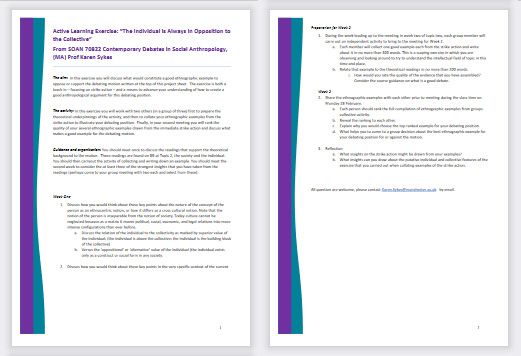Developing and Sharing Innovative and Responsive Assessment
In 2013, I took on the role of module convenor and lecturer for the core Masters-level module in Social Anthropology, ‘Contemporary Debates in Anthropology’. Historically, students on this module were assessed in a similar vein to other modules in the department, by written essay of 5,000 words. The Masters programme in anthropology is a conversion degree whereby students from a diversity of educational backgrounds are welcome to apply. Therefore, the students enrolled on this module rarely have a background in the discipline of anthropology. For instance, in the 2013-14 academic year, enrolled on this module was a drama school teacher, a hypnotherapist, an English Literature graduate, a retired police officer and a politics graduate, to name a few. The written assessment for this module was, previously, geared for a particular genre of writing for which most students had no previous or contemporaneous experience. Essay writing for anthropology became a particular barrier for the diversity of students who brought valuable, challenging and diverse ideas, questions and debates to open discussions. Their creativity, insights and experiences of the social issues we discussed in each lecture would push at the sensitive lines of significance of the subject matter with precision, and the students would raise new, innovative questions about persistent social issues.
What I did
My objectives as module convenor were to diversify the assessment by broadening opportunities for students with a diversity of backgrounds to engage with the subject matter in effective and inventive ways. The students were able to work within a space that allowed for the expression of their creativity and engagement with the subject in what was consistently a diverse cohort.
I took inspiration from what is now known as the ‘Unessay’ framework [1] whereby the option to be creative and innovative in their responses to assessment may take many forms, including but not limited to, storytelling, a film or play script, a short story, an interactive video, and structured debate to a set motion. For this module, I established weekly structured debates and open discussion as assessment. I set marking criteria collaboratively with the students, working with their expectations of what informative debate can and should ‘look like’ and why this form of assessment is useful for developing a meaningful engagement with the subject material (Race 1999: 58). I designed each set motion along core concerns with the subject materials covered in the module and each student had the opportunity to discuss, in both a structured and open debate their argument either for or against the motion. This allowed the students to argue for a position they disagreed with, to carve out an argument for something they personally refute. At the heart of my in-class and written feedback was the importance of seeing the same issue from another perspective, to identify the opportunities for critical thinking via different forms of argumentation, to learn how to disagree with an argument well, and to understand the value of informed debate.
Employing the sandwich method of feedback,[2] I began my feedback by starting with positive comments and praise. I follow this with constructive criticism on areas that need improvement, development and more reflection. Then I follow this feedback with further positive feedback. The purpose of the sandwich method of giving feedback is to create a pleasant and open atmosphere wherein students feel that any corrective feedback on their work is a learning opportunity rather than simply negative feedback.
Evaluation / Student Feedback
Enthusiasm for diversified assessment on this module was expressed in positive student feedback, both in class and in course unit evaluations. Indeed, this module received the highest level of positive student feedback in course unit evaluations in SoSS, in 2014. After each debate, the open discussion allowed for collective reflection on the motion and the opposing forms of argumentation presented by the debaters each week. Students were able to track and document their learning experience over the course of the module, make analytical connections to other module materials and identify the knowledge and skills they had acquired from previous coursework and experiences. They built upon their own ‘real world’ experiences as students with diverse backgrounds and were able to apply their own life and disciplinary backgrounds to theoretical frameworks covered in the subject material. Reflection was acknowledged each week as students made sense of how their own backgrounds play a key role in their learning, producing a sense of awareness of, confidence in, and a critical engagement with their own ideas.
Benefits
The students on this module thrived in this learning environment. As such, this form of assessment remains in place on this module to this day, maintained by each lecturer who takes on the teaching of this module each year. I have advised colleagues as they have transposed this form of assessment, and the ‘unessay’ approach to other modules, across year cohorts, including at undergraduate level, such as in the core second year module ‘Ethnographer’s Craft’ (SOAN 20842) (public speaking and presentations), and in the first-year option module ‘Introduction to Business Anthropology’ (SOAN 10361) (online observation exercises in various technological formats). The marking criteria for public presentation and debate that I collaboratively developed with my MA students has remained a useful resource for other colleagues in Social Anthropology and across SoSS who are teaching on these and other modules, to assess creative work produced by our students in an assortment of ‘unessay’ formats.
Top Tips
Why is it important and What next?
Upon reflection, the unessay model is one that must be used in a purposeful way that enhances an overall pedagogical strategy and learning experience specific to each module. Some students will prefer essay-based writing, which provides students with a specific and crucial set of transferable skills they can take with them beyond their degree. The unessay model may work well for some pedagogical strategies and less well for others. In this Case Study, I have demonstrated the importance of the development of transferable skills that are achievable when using an alternative assessment approach. Diversification of assessment must complement intended learning outcomes and aim to enhance the learning experience. As I share advice on creative assessment with my colleagues, including those new colleagues I have formally mentored, there is a consistency that I offer. I follow Andresen et al’s (1993) core strategies for setting assessment, some of which include reflecting on: 1.) whose interests the assessment is serving; 2.) avoiding over-grading (causing confusion for students); 3.) consider a variety of approaches to the subject material; and significantly, 4.) what forms will make subject matter most accessible and effective for a diversity of students in attendance (see also, Clouder et al. 2012; Brown and Glasner 1999: 5). Educational equity and pathways to successful inclusion within the classroom have significant impacts on quality of educational experience and learning for cohorts of students with such diverse culture, ethnicity, ambition and experience (Ainscow 2016; Awan 2019).
References
[1] For reference to more information about the ‘Unessay’ form of assessment, please see: https://journals.lww.com/jopte/Fulltext/2008/10000/Virtual_Action_Learning_Sets__A_Model_for.5.aspx (last accessed 19 June 2021).
[2] For more information about the sandwich method for providing constructive feedback, please see: https://www.ionos.co.uk/startupguide/productivity/sandwich-method/#:~:text=The%20sandwich%20method%20is%20a,appreciative%20words%20are%20used%20again. (last accessed 19 June 2021).
References
Ainscow, Mel. 2016. Struggles for Equity in Education. London: Routledge.
Andresen, L., P. Nightengale, D. Boud and D. Magin. 1993. Strategies for Assessing Students: A Guide to Setting, Marking, Grading and Giving Feedback on Assignments, Tests and Examinations. SCED Paper 78.
Awan, A.N. 2019. ‘The Unessay: Diversifying Assessment and Making Space for Creativity and Innovation in a Diverse Student Cohort’, online: https://intranet.royalholloway.ac.uk/staff/teaching/teaching-learning/the-unessay.aspx (Last accessed 19 June 2021)
Brown, S. and A Glasner (eds) 1999. Introduction. In Assessment Matters in Higher Education: Choosing and Using Diverse Approaches. Society for Research into Higher Education and Open University Press. Pp. 1-13.
Clouder, L., C. Broughan, S. Jewell and G. Steventon (eds) 2012. Improving Student Engagement and Development Through Assessment: Theory and Practice in Higher Education. London: Routledge.
Entwistle, N., S. Thompson and H. Tait. 1992. Guidelines for Promoting Effective Learning in Higher Education. Edinburgh: University of Edinburgh Press.
Evans, L. 2017. Implicit and information professional development: what it ‘looks like’, how it occurs, and why we need to research it, Professional Development in Education, 45/1: 3-16.
Race, P. 1999. Why Assess Innovatively? In S. Brown and A. Glasner (eds) Assessment Matters in Higher Education: Choosing and Using Diverse Approaches. Society for Research into Higher Education and Open University Press. Pp. 57-70.

School: School of Social Sciences
Discipline: Social Anthropology
Academic: Katherine Smith
Course: SOAN 70822 Contemporary Debates in Social Anthropology
Cohort Size: 20
Themes: Assessment innovation, assessment criteria
Ref: 014


0 Comments